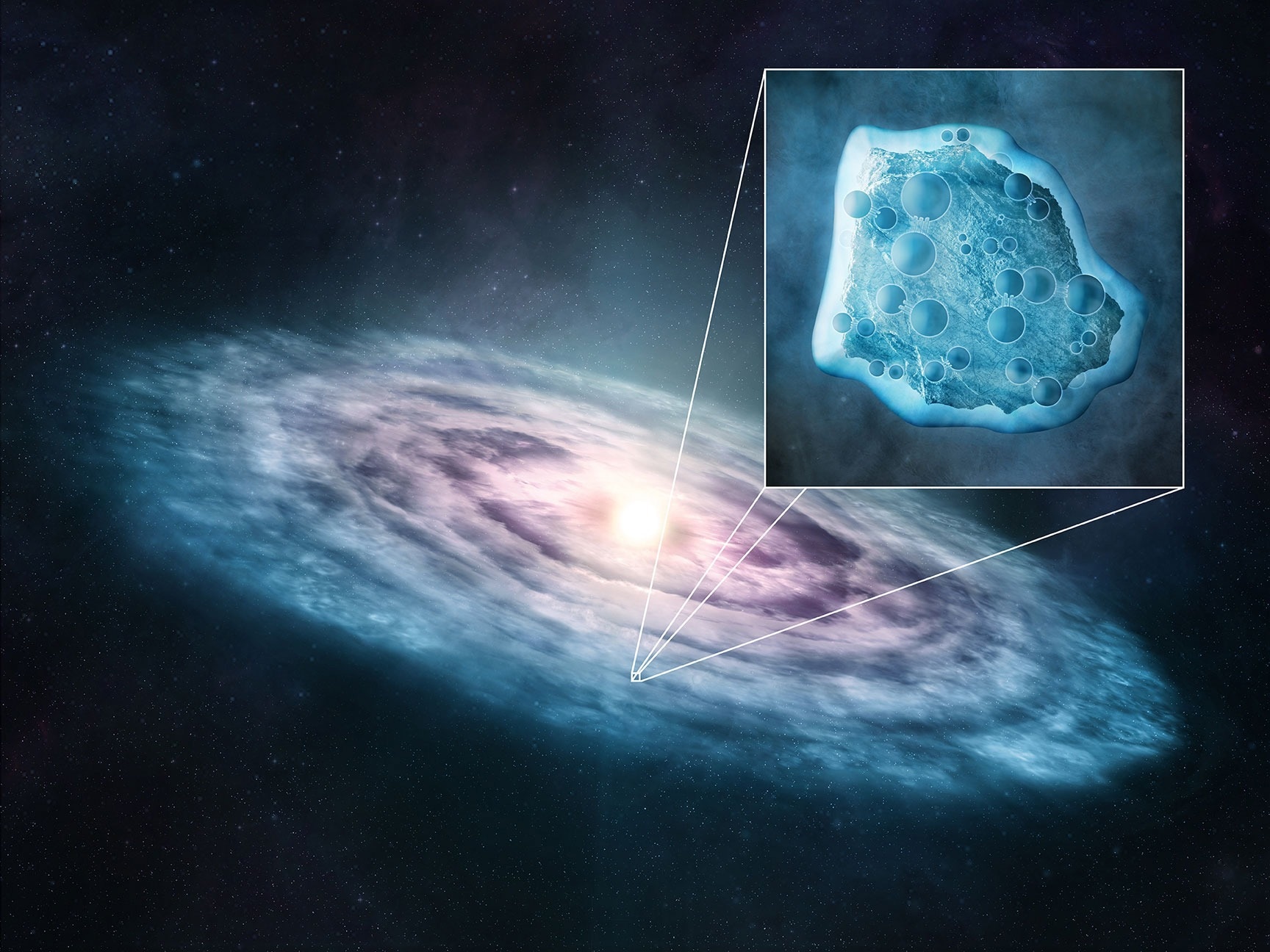Astronomers often study carbon monoxide in planetary nurseries. Carbon monoxide is extremely bright and widely found in protoplanetary disks — areas of gas and dust where planets are birthed around young stars — rendering it a major target for researchers.

Artist's illustration of a planetary disk, a region of dust and gas where planets form. The zoom-in insert displays carbon monoxide molecules in the ice phase. Image Credit: M.Weiss/Center for Astrophysics | Harvard & Smithsonian.
However, for the last 10 years or so, certain aspects have not been making sense regarding carbon monoxide observations, expresses a NASA Hubble Fellow Diana Powell at the Center for Astrophysics, Harvard and Smithsonian.
A massive portion of carbon monoxide has vanished from all observations of the disks if present predictions of its copiousness by the astronomers are accurate.
Currently, a new model — corroborated by observations with ALMA — has decoded the mystery: carbon monoxide has been concealed in ice formations inside the disks. The findings have been illustrated in the journal Nature Astronomy recently.
This may be one of the biggest unsolved problems in planet-forming disks. Depending on the system observed, carbon monoxide is three to 100 times less than it should be; it's off by a really huge amount.
Diana Powell, Study Lead and NASA Hubble Fellow, Center for Astrophysics, Harvard and Smithsonian
Carbon monoxide imprecisions could have enormous implications for the domain of astrochemistry.
Carbon monoxide is essentially used to trace everything we know about disks — like mass, composition, and temperature. This could mean many of our results for disks have been biased and uncertain because we don't understand the compound well enough.
Diana Powell, Study Lead and NASA Hubble Fellow, Center for Astrophysics, Harvard and Smithsonian
Fascinated by the mystery, the NASA Hubble researcher wore her detective hat and relied on her know-how in the physics underlying phase changes — when matter transforms from one state to another, like a gas turning into a solid.
On an instinct, Powell carried out modifications to an astrophysical model that is presently used to observe clouds on exoplanets, or planets surpassing the solar system.
What's really special about this model is that it has detailed physics for how ice forms on particles. So how ice nucleates onto small particles and then how it condenses. The model carefully tracks where ice is, on what particle it's located on, how big the particles are, how small they are, and then how they move around.
Diana Powell, Study Lead and NASA Hubble Fellow, Center for Astrophysics, Harvard and Smithsonian
Powell applied the modified model to planetary disks, expecting to bring about a comprehensive understanding of how carbon monoxide transforms over time in planetary nurseries. To test the model’s correctness, Powell then compared its results to actual ALMA observations of carbon monoxide in four well-researched disks — HD 163296, TW Hya, DM Tau, and IM Lup.
The models and results functioned very well, Powell states.
The new model matched with each of the observations, revealing that carbon monoxide was not missing from the four disks at all — it had only changed into ice, which is presently untraceable with a telescope.
Radio observatories such as ALMA allow astronomers to observe carbon monoxide in space in its gas phase, but ice is a lot harder to spot with existing technology, particularly large ice formations, Powell states.
The model illustrates that in contrast to previous thinking, carbon monoxide is developing on large units of ice — particularly after one million years. Before a million years, gaseous carbon monoxide was plentiful and visible in disks.
"This changes how we thought ice and gas were distributed in disks," Powell states. "It also shows that detailed modelling like this is important to understand the fundamentals of these environments."
Powell is optimistic that her model can be further authenticated using observations with NASA’s Webb Telescope, which may be adequately robust to finally spot ice in disks.
Powell, who enjoys phase variations and the complex processes underlying them, says she is amazed by their effect.
"Small-scale ice formation physics influences disk formation and evolution — now that’s really cool."
Journal Reference
Powell, D., et al. (2022) Depletion of gaseous CO in protoplanetary disks by surface-energy-regulated ice formation. Nature Astronomy. doi.org/10.1038/s41550-022-01741-9.